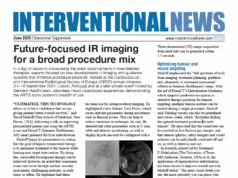A wealth of data emerging in the last 18 months, including from a small multicentre, randomised, sham-controlled study of genicular artery embolization for knee pain secondary to osteoarthritis, brings in its slipstream a glimpse of other similar minimally invasive options to treat disability in the entire musculoskeletal system. Embolization, which is rapidly surfacing as a safe and effective procedure for the treatment of patients with osteoarthritis of the knee, has been shown to be technically achievable, with very promising outcomes at early follow-up. It is thought to bring down pain by reducing synovial arterial hypervascularity.
A multicentre, randomised, single-blinded, sham-controlled study published online ahead of print in October 2021 in the Journal of Vascular and Interventional Radiology (JVIR) showed that, in patients with mild-to-moderate knee osteoarthritis, embolization results in symptomatic improvement greater than the sham procedure did, with clinically significant reduction in pain and disability (as measured by the Visual Analogue Score [VAS] and Western Ontario and McMaster Universities Osteoarthritis Index [WOMAC]). In the 21-patient study, all those assigned to the sham group failed to show significant improvements at one month and crossed over to the treatment arm.
“Genicular artery embolization has the potential to be one of the most commonly performed embolization procedures for interventional radiologists in the near future and make a substantial impact in the lives of millions of patients. The data from our study demonstrate that the effect of embolization in reducing pain and improving function is far greater than the effect of a sham procedure or placebo. This study will be useful in convincing potential referrers as well as insurance companies that this procedure should be part of the osteoarthritic knee pain treatment algorithm. What is most exciting is that this procedure may just be the first of many different embolization procedures that will be utilised to treat pain throughout the musculoskeletal system,” Ari J Isaacson, University of North Carolina at Chapel Hill School of Medicine, Chapel Hill, USA, and one of the researchers on the sham trial, tells Interventional News.
These investigators further reported statistically significantly greater pain reduction captured by VAS in the treatment group when compared to those undergoing the sham treatment at one month (p<0.01). Disability improvement was also significantly greater in the treatment group (p=0.02).
“Genicular artery embolization has given many of my patients, some of whom have previously given up trying to control their pain, new opportunities to live more fulfilling lives. Often, these patients do not respond to conservative management, but are precluded by their comorbidities from having a knee replacement. Embolization can be performed with permanent particles, which have been shown to be safe, or temporary agents such as an imipenem/cilastatin slurry. The embolization technique itself is also constantly evolving to become safer and more effective. Examples include using ice packs on the skin, which have significantly decreased the rates of cutaneous non-target embolization that results in skin ulcerations. Of course, more knowledge is necessary, and important studies are on the horizon. Nevertheless, we should recognise that we do not yet fully understand the mechanism of action of this treatment. With careful due diligence, however, I think we can help many patients. For instance, I treat with temporary embolics rather than permanent embolics, and tend to treat patients who also have more severe disease and more pain,” says Yilun Koethe, Oregon Health and Science University, Oregon, USA.
Another recent publication that set out to evaluate the safety and efficacy of embolization for the treatment of symptomatic knee osteoarthritis found the procedure to be “effective and durable in reducing pain symptoms from moderate or severe knee osteoarthritis that is refractory to other conservative therapy, with an acceptable safety profile.
”Siddarth A Padia (Division of Interventional Radiology, Department of Radiology, David Geffen School of Medicine at University of California Los Angeles, Los Angeles, USA) and colleagues write that in their 40-patients study, the WOMAC total and VAS pain scores decreased by 61% and 67% at 12 months from a median baseline of 52 (of 96) and 8 (of 10), respectively. Sixty-eight percent of patients had a reduction of ≥50% in both WOMAC total and VAS pain scores.
The prospective, single-centre, open-label US Food and Drug Administration-approved investigational device exemption study was published in October 2021 in the Journal of Bone & Joint Surgery.
Padia and colleagues pointed to transient skin discolouration and transient mild knee pain after the procedure being “common and expected”. Treatment-related adverse events included a groin haematoma requiring overnight observation, self-resolving focal skin ulceration, and an asymptomatic small bone infarct on magnetic resonance imaging (MRI) at three months.
“Other than total knee arthroplasty, treatments for knee osteoarthritis have been limited in effect and duration. Research over the past several decades has failed to improve treatment options for this common ailment. Genicular artery embolization looks to be a promising breakthrough therapy for symptomatic knee osteoarthritis. Our trial showed that embolization demonstrated a marked reduction in pain and improvement in function in 68% of study participants, with minimal adverse events. Moreover, the duration of effect was seen to at least one year. These results will serve as a platform for a large-scale randomised trial, which will hopefully begin in 2022,” Padia told this newspaper.
If the evidence-base carries on being augmented for genicular artery embolization, experts believe that its impact can be widespread. “Knee pain from arthritis affects many people of different backgrounds, genders, ethnicities, and ages. Embolization has the potential to improve the lives of different kinds of patients all over the world,” Theresa Caridi, University of Alabama at Birmingham, Birmingham, USA, contends.
Mark Little, University Department of Radiology, Royal Berkshire NHS Foundation Trust, Reading, UK, commented: “Over the last 18 months, there has been increasing amounts of data within the literature.All studies have reported consistent results; embolization is a safe and potentially effective treatment for patients with osteoarthritis of the knee. The recent study that randomised 21 patients to receive genicular artery embolization or a sham procedure was the first paper to address the placebo effect. Our own interim data from the GENESIS study, which was published in CardioVascular and Interventional Radiology in January 2021, revealed a significant improvement in pain and function at one-year follow-up, in addition to an improvement in synovitis on contrast-enhanced MRI. Embolization for this indication clearly has the potential to offer a unique, minimally invasive treatment to the millions of patients with symptomatic knee osteoarthritis, which could change the way in which we treat the disease! More data are needed to study the long-term outcomes of the procedure, the health economics associated with it, and the ideal embolic agent. Further randomised controlled studies are warranted comparing it to a sham procedure, and best medical therapy, in order to improve data generalisability. My group is extremely excited to commence recruitment for GENESIS II, a large randomised, sham-controlled trial for genicular artery embolization at the beginning of 2022. The future seems vibrant for this procedure.”













